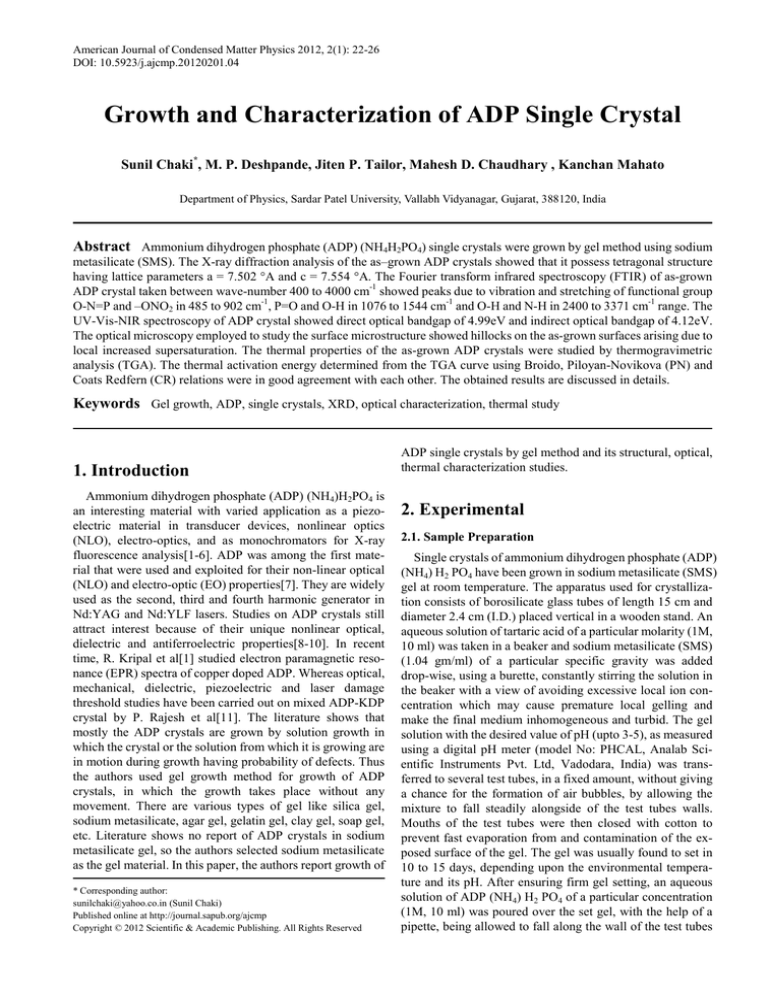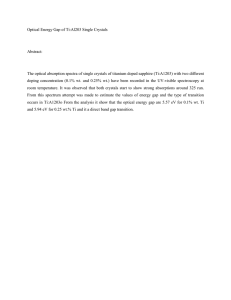
American Journal of Condensed Matter Physics 2012, 2(1): 22-26
DOI: 10.5923/j.ajcmp.20120201.04
Growth and Characterization of ADP Single Crystal
Sunil Chaki*, M. P. Deshpande, Jiten P. Tailor, Mahesh D. Chaudhary , Kanchan Mahato
Department of Physics, Sardar Patel University, Vallabh Vidyanagar, Gujarat, 388120, India
Abstract Ammonium dihydrogen phosphate (ADP) (NH4H2PO4) single crystals were grown by gel method using sodium
metasilicate (SMS). The X-ray diffraction analysis of the as–grown ADP crystals showed that it possess tetragonal structure
having lattice parameters a = 7.502 °A and c = 7.554 °A. The Fourier transform infrared spectroscopy (FTIR) of as-grown
ADP crystal taken between wave-number 400 to 4000 cm-1 showed peaks due to vibration and stretching of functional group
O-N=P and –ONO2 in 485 to 902 cm-1, P=O and O-H in 1076 to 1544 cm-1 and O-H and N-H in 2400 to 3371 cm-1 range. The
UV-Vis-NIR spectroscopy of ADP crystal showed direct optical bandgap of 4.99eV and indirect optical bandgap of 4.12eV.
The optical microscopy employed to study the surface microstructure showed hillocks on the as-grown surfaces arising due to
local increased supersaturation. The thermal properties of the as-grown ADP crystals were studied by thermogravimetric
analysis (TGA). The thermal activation energy determined from the TGA curve using Broido, Piloyan-Novikova (PN) and
Coats Redfern (CR) relations were in good agreement with each other. The obtained results are discussed in details.
Keywords Gel growth, ADP, single crystals, XRD, optical characterization, thermal study
1. Introduction
Ammonium dihydrogen phosphate (ADP) (NH4)H2PO4 is
an interesting material with varied application as a piezoelectric material in transducer devices, nonlinear optics
(NLO), electro-optics, and as monochromators for X-ray
fluorescence analysis[1-6]. ADP was among the first material that were used and exploited for their non-linear optical
(NLO) and electro-optic (EO) properties[7]. They are widely
used as the second, third and fourth harmonic generator in
Nd:YAG and Nd:YLF lasers. Studies on ADP crystals still
attract interest because of their unique nonlinear optical,
dielectric and antiferroelectric properties[8-10]. In recent
time, R. Kripal et al[1] studied electron paramagnetic resonance (EPR) spectra of copper doped ADP. Whereas optical,
mechanical, dielectric, piezoelectric and laser damage
threshold studies have been carried out on mixed ADP-KDP
crystal by P. Rajesh et al[11]. The literature shows that
mostly the ADP crystals are grown by solution growth in
which the crystal or the solution from which it is growing are
in motion during growth having probability of defects. Thus
the authors used gel growth method for growth of ADP
crystals, in which the growth takes place without any
movement. There are various types of gel like silica gel,
sodium metasilicate, agar gel, gelatin gel, clay gel, soap gel,
etc. Literature shows no report of ADP crystals in sodium
metasilicate gel, so the authors selected sodium metasilicate
as the gel material. In this paper, the authors report growth of
* Corresponding author:
sunilchaki@yahoo.co.in (Sunil Chaki)
Published online at http://journal.sapub.org/ajcmp
Copyright © 2012 Scientific & Academic Publishing. All Rights Reserved
ADP single crystals by gel method and its structural, optical,
thermal characterization studies.
2. Experimental
2.1. Sample Preparation
Single crystals of ammonium dihydrogen phosphate (ADP)
(NH4) H2 PO4 have been grown in sodium metasilicate (SMS)
gel at room temperature. The apparatus used for crystallization consists of borosilicate glass tubes of length 15 cm and
diameter 2.4 cm (I.D.) placed vertical in a wooden stand. An
aqueous solution of tartaric acid of a particular molarity (1M,
10 ml) was taken in a beaker and sodium metasilicate (SMS)
(1.04 gm/ml) of a particular specific gravity was added
drop-wise, using a burette, constantly stirring the solution in
the beaker with a view of avoiding excessive local ion concentration which may cause premature local gelling and
make the final medium inhomogeneous and turbid. The gel
solution with the desired value of pH (upto 3-5), as measured
using a digital pH meter (model No: PHCAL, Analab Scientific Instruments Pvt. Ltd, Vadodara, India) was transferred to several test tubes, in a fixed amount, without giving
a chance for the formation of air bubbles, by allowing the
mixture to fall steadily alongside of the test tubes walls.
Mouths of the test tubes were then closed with cotton to
prevent fast evaporation from and contamination of the exposed surface of the gel. The gel was usually found to set in
10 to 15 days, depending upon the environmental temperature and its pH. After ensuring firm gel setting, an aqueous
solution of ADP (NH4) H2 PO4 of a particular concentration
(1M, 10 ml) was poured over the set gel, with the help of a
pipette, being allowed to fall along the wall of the test tubes
American Journal of Condensed Matter Physics 2012; 2(1): 22-26
so as to prevent the gelled surface from cracking. The resulting gel-liquid interface is then allowed to stand for 3 to 4
weeks. During this time a number of colourless good quality
transparent crystals appear in the gel medium which is
shown in the Figure 1.
23
gel grown ADP single crystals were determined from the
X-ray diffraction pattern obtained employing X-ray diffractometer. The diffraction peaks of the XRD patterns
shown in Figure 2 could be indexed as those of the ADP with
tetragonal structure (JCPDS Card No.37-1479). The XRD
peaks were indexed and crystallographic lattice parameters
were determined by powder-X software. The determined
lattice parameters are a = 7.502 °A and c = 7.554 °A having
space group 𝐼𝐼42𝑑𝑑 .The lattice parameters are in good
agreement with the reported values[12].
Figure 2. X-ray powder diffraction of ADP
3.2. Fourier Transform Infrared Spectroscopy (FTIR)
The functional groups of pure ADP crystals involved in
vibration frequency have been identified using FTIR spectroscopy.
Figure 1. Photograph of transparent ADP single crystal
2.2. Characterization of ADP Single Crystals
The crystallographic lattice parameters of the gel grown
ADP single crystals were determined using X-ray diffraction
employing Philips X-ray diffractometer X-pert-MPD using
CuKα radiation in the 2θ range of 15o-90o. The FTIR spectrum was recorded in the regions 400 – 4000 cm−1 using a
Perkin-Elmer FTIR Spectrometer [GX Spectrometer] by
KBr pellet technique. The optical properties of as-grown
ADP crystals were studied using UV-Vis-NIR spectrophotometer Perkin Elmer Lambda-19 in the range of 185 nm to
3200 nm. The surfaces of the gel grown ADP crystals were
examined under ‘Axiotech 100 HD’ optical microscope
[Carl Ziess (India) Pvt. Ltd, Bangalore, India] for their microstructures. The thermal analysis of the single crystals of
ADP was done by Thermogravimetric analyser. The thermograph (TG) was acquired from ambient (300 K) to 873 K
at a heating rate of 5 °C/min in inert (Nitrogen) atmosphere
using a Perkin-Elmer Pyris-1 TGA.
3. Results and Discussion
3.1. Structural Studies (XRD)
The crystallographic structure and lattice parameters of
Figure 3. FTIR spectrum of ADP single crystal
The gel grown ADP FTIR spectrum was taken between
wave-number 400 to 4000 cm-1, shown in Figure 3. The
peaks between 485 to 902 cm-1 are due to the O-N=P and
–ONO2 bond vibration in ADP crystal. Whereas P=O and
O-H are responsible for the peaks in the wave-number range,
1076 to 1544 cm-1. In the wave-number range from 2400 to
3371 cm-1, the numbers of peaks are lesser than the above
two wave-number ranges. These peaks are due to O-H and
N-H stretching[13].
24
Sunil Chaki et al.: Growth and Characterization of ADP Single Crystal
3.3. Optical Studies UV-Vis-NIR Spectroscopy
The optical properties of as-grown ADP single crystals
were studied using UV-Vis-NIR spectrophotometer in the
range of 185 nm to 3200 nm. The absorption spectrum of the
as-grown ADP single crystals is shown in Figure 4.
Figure 5. Plot of (a) (αhν)2 versus hν giving direct band gap (b) (αhν)1/2
versus hν giving indirect band gap
3.4. Optical Microscopy
The most common features visible on the as-grown surfaces of gel grown ADP were hillocks as shown in Figure 6.
Figure 4. Absorption spectrum of ADP single crystal
The optical band gap of the ADP single crystal was determined from the absorption spectrum using the near-band
edge absorption relation,
(1)
(αhν)n = A (hν – Eg)
Where A - the optical transition dependent constant, Eg optical energy bandgap, ν - the frequency of incident beam, h
- Planck’s constant, n - characterizes the transition. For direct
allowed and forbidden transitions, n = 2 and 2/3 respectively,
and n = 1/2 and 1/3 for indirect allowed and forbidden transitions, respectively.
The analysis of equation[1] showed that, n = 2 and ½ fitted
for the as-grown ADP single crystal samples confirming
direct and indirect allowed transition. Figure 5(a) and 5(b)
shows the plot of (αhν)2 against hν and (αhν)1/2 against hν
respectively for ADP crystals. The intercept of the straight
line on the photon energy axis gives the direct bandgap value
of 4.99 eV and indirect bandgap value of 4.12 eV.
Figure 6. Optical micrograph of gel grown ADP single crystals
There is no satisfactory interpretation of such large nondislocation hillocks in the literature. The only explanation
available is that, they are produced by the two dimensional
nucleation at some points on the surface due to impurities in
the growth environments and when the supersaturation at
some points on the growing surface of the crystal is higher
than that of the rest of the surface. Due to this local increased
supersaturation, these points act as centres of repeated
two-dimensional nucleation for growth fronts, which spread
and pile upon one another to produce the hillocks.
3.5. Thermogravimetric Analysis
Figure 7. TGA curve of ADP single crystal
American Journal of Condensed Matter Physics 2012; 2(1): 22-26
The thermogravimetric curve obtained for gel grown ADP
in inert atmosphere is shown in Figure 7. The curve clearly
shows that the ADP crystal is stable between the temperature
range of ambient to 473 K (the melting point of ADP).
Above 473 K to 873 K, the weight loss in total is of ∼ 80%.
The maximum weight loss in one step (473 K to 523 K) is
~63%. The activation energy calculation using this weight
loss in temperature range 473 K to 523 K was carried out
using Broido, Piloyan-Novikova (P-N) and Coats-Redfern
(C-R) relations[14]. The plot of Broido, Piloyan-Novikova
(P-N) and Coats-Redfern (C-R) is shown in Figure 8. The
activation energy obtained from the plots of these three relations is tabulated in Table 1. The values are in good
agreement with each other.
25
Table 1. Kinetic parameters evaluated from the non-mechanistic equations for gel grown ADP crystals
Method
Activation
energy Ea in eV
Broido
relation
Piloyan-Novikova
(P-N) relation
Coats-Redfern
(C-R) relation
0.354
0.327
0.297
4. Conclusions
Good quality transperent single crystals of ammonium
dihydrogen phosphate (ADP) (NH4 H2 PO4) have been
grown in sodium metasilicate (SMS) gel at room temperature.
The X-ray diffraction pattern of the gel grown ADP showed
the crystals possess tetragonal structure with lattice parameters in good agreement with the reported data (JCPDS
Card No.37-1479). The functional groups of ADP crystals
involved in vibration frequency were identified using FTIR.
The optical bandgap values determined from the optical
absorbance study of the crystals showed direct bandgap
value of 4.99 eV and indirect bandgap value of 4.12 eV. The
most common features visible on the as-grown surfaces of
gel grown ADP were hillocks, this was due to local increased
supersaturation. The thermogravimetric curve obtained for
gel grown ADP in inert atmosphere in temperature range
ambient to 873 K, shows that the gel grown ADP crystal is
stable between room temperature and 473 K (the melting
point of ADP). Above 473 K to 873 K, the weight loss is ∼
80%. The maximum weight loss of ~63% in one step is in
temperature range 473 K to 523 K. The activation energy
value calculation in temperature range 473 K to 523 K using
Broido, Piloyan-Novikova (P-N) and Coats-Redfern (C-R)
relations are in good agreement with each other.
REFERENCES
Figure 8. Plot of (a) Broido relation (b) Piloyan-Novikova (P-N) relation
(c) Coats-Redfern (C-R) relation
[1]
Ram Kripal, Santwana Shukla, Prashant Dwivedi, EPR and
optical studies of Cu2+ doped ammonium dihydrogen phosphate single crystals, Physica B 407 (2012) 656-663.
[2]
P. Rajesh, K. Boopathi, P. Ramasamy, Investigations on the
solubility, growth, structural, optical, mechanical, dielectric
and SHG behaviour of ammonium acetate doped ammonium
dihydrogen phosphate crystals, J Crystal Growth 318 (2011)
751-756.
[3]
K. Srinivasan, A. Cantoni, G. Bocelli, Compositional dependence of morphology and lattice parameters during
growth of K1-x(NH4)xH2PO4 mixed crystals, Cryst. Res.
Technol. 45(7) (2010) 737-746.
[4]
R. Ananda Kumari, Growth and characterization of NLO
crystal, Ind. J. Pure & Appl. Phys. 47 (2009) 369-371.
[5]
Y. Asakuma, Q. Li, H. M. Ang, M. Tade, K. Maeda, K. Fukui,
A study of growth mechanism of KDP and ADP by means of
quantum chemistry, Appl. Surface Sci. 254(15) (2008)
4524-4530.
[6]
Xiue Ren, Dongli Xu, Dongfeng Xue, Crystal growth of KDP,
ADP, and KADP, J Crystal Growth 310 (2008) 2005-2009.
26
Sunil Chaki et al.: Growth and Characterization of ADP Single Crystal
[7]
Dongfeng Xue and Henryk Ratajczak, Effect of hydrogen
bonds on physical properties of ammonium dihydrogenphosphate crystals, J Molecular Structure: Theochem. 716
(2005) 207-210.
[8]
K. Sethuraman, R. Ramesh Babu, R. Gopalkrishnan, P. Ramasamy, Unidirectional growth of 〈1 1 0〉 ammonium
dihydrogen orthophosphate single crystal by Sankaranarayanan–Ramasamy method, J Crystal Growth 294 (2006)
349-352.
[9]
A. P. Voronov, V. I. Salo, V. M. Puzikov, G. N. Babenko, A.
D. Roshal, V. F. Tkachenko, Hybrid organic-inorganic crystals based on ammonium dihydrogen phosphate and ammonium salicylate, J Crystal Growth 335 (2011) 84-89.
[10] P. Rajesh, P. Ramasamy, Binay Kumar, G. Bhagavannarayana, Effect of cobalt and DL-malic acid on the growth rate,
crystalline perfection, optical, mechanical, dielectric, piezoelectric properties and SHG efficiency of ADP single
crystals, Physica B 405 (2010) 2401-2406.
[11] P. Rajesh, P. Ramasamy, G. Bhagavannarayana, Growth of
ADP-KDP mixed crystal and its optical, mechanical, dielectric, piezoelectric and laser damage threshold studies, J.
Crystal Growth, doi:10.1016/j.jcrysgro.2011.10.036.
[12] P. Shenoy, K. V. Bangera, G. K. Shivakumar, Growth and
thermal studies on pure ADP, KDP and mixed
K1-x(NH4)xH2PO4 crystals, Cryst. Res. Technol. 45 (2010)
825-829.
[13] Russel S Drago, Physical Method in Inorganic Chemistry
(Chapter 7), East-West Press Pvt. Ltd, New Delhi (1968).
[14] Sunil. H. Chaki, Thermal decomposition studies of CuInS2,
Front. Mater. Sci .China, 2(3) (2008) 322-325.






